










By Joel R. San Juan
FROM August to October of this year, the Bureau of Corrections (BuCor) has released a total of 740 persons deprived of liberty (PDLs) as part of the current administration’s program to decongest the country’s prison facilities.
This brings the number of PDLs freed under the more than two-year term of President Ferdinand Marcos Jr. to a total of 16,657. Meanwhile, more than 5,000 out of 27,311 PDLs convicted of heinous crimes are expected to be released before the year ends after the Supreme Court ruled with finality that persons convicted of heinous crimes are entitled to the benefits of Republic Act No. 10592, or the New Good Conduct Time Allowance (GCTA) law.
In December 2023, all three branches of the government—the Executive, the Legislative and the Judiciary—came together in the National Decongestion Summit, spearheaded by the Justice Sector Coordinating Council (JSCC), to find solutions to jail and prison overcrowding. The JSCC is composed of the Supreme Court (SC), the Department of Justice (DOJ), and the Department of the Interior and Local Government (DILG). During the event, Chief Justice Alexander Gesmundo stressed that the efficiency and efficacy of any criminal justice system is measured not by how many are prosecuted and incarcerated, but rather by how many are reformed and rehabilitated.
Gesmundo, however, admitted that the conditions of the country’s jails and detention facilities are not humane.
Gesmundo said that the Summit “will go beyond mere talk and discussion” and stressed that JSCC will already lay down its plan of action for addressing congestion.
Despite these efforts, the alarming inhumane conditions of

those still serving their prison terms are far from being resolved, as prison facilities are expected to remain congested in the coming years.
In fact, the occupancy rate of the country’s penal facilities remains high at more than 230 percent as of May 31, 2024, as the PDLs’ population continues to rapidly increase, reaching more than 53,000 as of the same period.
Justice Secretary Jesus Crispin Remulla, during the Senate’s budget hearing for the 2025 National Expenditure Program for the Judiciary in August, described the congestion problem of correction facilities as “unmanageable” and the conditions of PDLs as “pitiful.”
He lamented that the government has other important priorities in the allocation of budget, which explains the huge cut in the proposed 2025 budget for the BuCor. BuCor submitted a budget proposal for fiscal year 2025 amounting to P24.5 billion to address the challenges posed by high occupancy and congestion rates in various operating prison and penal farms, but was only given an appropriation of P9.243 bil-

lion, or less than half.
The proposed budget was supposed to be spent for the construction and expansion of current prison facilities and rehabilitation of infrastructure to improve their capacity and the living conditions of PDLs, which is deemed crucial for rehabilitation.
Aside from the NBP, the BuCor is currently operating seven penal and prison facilities, such as the Davao Prison and Penal Farm (DPPF), Iwahig Prison and Penal Farm (IPPF) in Palawan, San Ramon Prison and Penal Farm (SRPPF) in Zamboanga, Sablayan Prison and Penal Farm
(SPPF) in Occidental Mindoro, Leyte Regional Prison (LRP) and the Correctional Institute for Women (CIW) in Mandaluyong City.
Out of the seven prison facilities, the NBP in Muntinlupa City stands out with the highest occupancy rate, reaching 292 percent with its PDL population of 28,892 occupying space for a maximum capacity of 9,885 for its land area.
The DPPF has a PDL population of 8,707 as of May 2024 despite its capacity of only 1,350, or an occupancy rate of 645 percent; IPPF has a 4,430 PDL population, although its capacity is only 645, or an occu-
pancy rate of 687 percent; SRPPF has a 3,721 PDL population for a maximum capacity of 711, or 523-percent occupancy rate; SPPF has more than 3,000 PDLs with a maximum capacity of 1,175, or an occupancy rate of 284 percent; LRP’s PDL population has reached more than 3,000 with a maximum capacity of only 687, or 481-percent occupancy rate; and CIW with more than 3,000 PDLs, although its maximum capacity is only 1,008, or an occupancy rate of 309 percent.
No expansion, more congestion CHIEF Justice Gesmundo has stressed that the congestion prob-
lem of jail prison facilities cannot be addressed without the corresponding expansion of jail facilities. He noted that 70 percent of detention facilities under the Bureau of Jail Management and Penology are overcrowded, at an average congestion rate of 386 percent. Even worse, the occupancy rate in some jails has gone as high as 2,748 percent of their standard capacity, according to the chief magistrate.
Remulla also conceded that mega prisons like the NBP are already considered taboo around the world, as they dehumanize the PDLs’ conditions. Thus, the DOJ and the BuCor are pushing for the decentralization of prison facilities before 2028. However, the plan would have to take the backseat because of budgetary constraints.
“What was not given by the national government in terms of our submission was the BuCor prison modernization program, which aimed to introduce a decentralized jail system instead of having mega prisons,” Remulla told the Senate. This would mean that the construction of regional facilities as embodied in Republic Act 10575, or the Bureau of Corrections Modernization Act, will have to wait. Under the proposed 2025 NEP, the construction of various facilities under the BuCor was only given an appropriation of P853.179 million. This would include the construction of two units of two-story dormitory at DPPF amounting to P100 million; two units of two-story dormitory at IPPF worth P273.2 million; one unit of two-story dormitory at SRPPF in the amount of P180 million; and P300 million for the second-year construction of a Super Maximum Security Facility at SPPF.
“It’s really a pitiful situation we have right now, that’s why we wanted to decentralize the prison system and to build regional jails, at least 15 regional jails throughout the country,” Remulla earlier lamented. Remulla said the DOJ is exploring the possibility of entering into public-private partnership arrangements to address the urgent problem.
By Jonathan Mattise, Travis Loller & Kristin M. Hall The Associated Press
THE leading private prison company in the US has spent more than $4.4 million to settle dozens of complaints alleging mistreatment— including at least 22 inmate deaths—at its Tennessee prisons and jails since 2016.
More than $1.1 million of those payouts involved Tennessee’s largest prison, the long-scrutinized Trousdale Turner Correctional Center, which is now under federal investigation.
Details of nearly 80 settlements provided to The Associated Press through public records requests allege brutal beatings, medical neglect and cruelty at CoreCivic’s four prisons and two jails in Tennessee.
In one case, a Trousdale inmate who feared for his life beat his cellmate, Terry Childress, to death to get transferred to a different prison, the federal lawsuit says. No guards came to Childress’ aid at the chronically understaffed facility, the suit claims. Childress’ family received a $135,000 settlement.
The US Department of Justice recently announced an investigation of Trousdale, noting that reports of violence have been endemic since its 2016 opening. The investigation comes after years of well-documented “reports of physical assaults, sexual assaults, murders and unchecked flow of contraband and severe staffing shortages,” US Attorney Henry Leventis has said.
“It does certainly appear as though settling lawsuits is a cost of doing business, rather than an alarm, a wake-up call, a siren,” said Mary Price, general counsel of Families Against Mandatory Minimums, which advocated for the Trousdale investigation.
CoreCivic, headquartered in Brentwood, Tenn., has a value of
The family’s attorney, Daniel Horwitz, was ordered by a judge to stop publicly disparaging CoreCivic and to take down tweets calling it a “death factory.” He is suing over the gag order.


$1.44 billion as measured by market capitalization.
Many took a long road to a small settlement SURVIVING inmates or grieving families have often fought for years to reach settlements. Some advocated publicly for their cases, speaking to news outlets and participating in demonstrations. But accepting a settlement generally required quieting down. And, typical of settlements across industries, CoreCivic did not admit any wrongdoing.
The largest settlement was for $900,000 over a South Central Correctional Facility inmate’s suicide where staff falsified records. Three others were for about $300,000 apiece.
But those payouts were the exception. Half the settlements were for $12,500 or less. Some involved no money at all.
“In a lot of these cases, unfortunately, victims and family members of victims are in this position to choose between some amount of money, which is probably more than they’ve seen in a long time, or speaking their truth and sharing their stories and really being able to do something that brings this to an end,” said Ashley Dixon, a whistleblower who worked less than a year as a Trousdale corrections officer.
A CoreCivic spokesperson, Ryan Gustin, declined to comment on specific settlements, saying most have confidentiality terms. He said the corrections industry generally has had staffing issues and pointed to CoreCivic’s hiring incentives and strategies to backfill with workers from other facilities nationally. He said CoreCivic facilities offer “comprehensive medical and mental health care” and are closely monitored by the state.
The settlements make up a fraction of the lawsuits CoreCivic has faced over its Tennessee facilities. The 22 death settlements are also only a fraction of the 300-plus deaths in the four CoreCivic prisons since 2016.
More than half the hundreds of deaths were deemed natural, including Jonathan Salada, who lay on his cell floor at Trousdale crying in pain after being denied diabetes medication, according to a 2018 lawsuit. He was taken to the infirmary but returned to his cell twice before being found unconscious
three days later and pronounced dead at the hospital. The lawsuit was settled for $50,000.
‘I feel unsafe at all times’
THE settled lawsuits claim that even critical staff positions are sometimes unfilled at CoreCivic prisons, leaving inmates unprotected and unable to get help when attacked.
Adrian Delk received a $120,000 settlement after seven gang members nearly beat him to death for “between 20 minutes and one hour” with no one to intervene at Hardeman in 2016, according to his lawsuit. He was later stabbed and beaten again, suffering several permanent injuries.
Prison workers are not immune from the violence. At Trousdale in 2019, a counselor lost an eye and suffered other permanent injuries when an inmate attacked her with a homemade knife and raped her. Officials had withheld the inmate’s antipsychotic medication as punishment for illegal drug use.
In a 2023 state audit, a guard noted: “While at Trousdale, I feel unsafe at all times.”
Leventis, the US attorney, noted that Tennessee has known of problems at its CoreCivic facilities. The state’s corrections agency has fined CoreCivic $37.7 million across four prisons since 2016, including $11.1 million for problems at Trousdale. The violations include failures to meet staffing requirements. The state comptroller released scathing audits in 2017, 2020 and 2023.
Yet state leaders have consistently downplayed the problems and renewed contracts with CoreCivic, a company that figures prominently in political spending. Tennessee is CoreCivic’s largest state customer, accounting for 10% of total revenue in 2023, according to a corporate filing. CEO Damon Hininger has even floated running for governor in 2026.
“CoreCivic has been a very important partner to the state,” Republican Gov. Bill Lee told reporters after the Trousdale investigation announcement. When Dixon, the former Trousdale guard, testified to state lawmakers in 2017 about the deaths of Salada and a second prisoner, Jeff Mihm, the committee chairman tried to cut her off at a two-minute limit.
“She just told you about a death in one of our facilities, and we’re going to cut her off?” replied Democratic Rep. Bo Mitchell, prompting applause. Mihm also had been denied psychiatric medication and treatment at Trousdale and killed himself in 2017, according to a lawsuit that eventually settled for $5,000.
“I think it’s very sad that it’s a small amount that they receive, because those people’s lives were worth much more than that,” Dixon told the AP after learning about the settlements.
Lack of medical care played a role MANY of the settled cases claim inmates were denied basic preventive care—diabetes medication, an inhaler, a walking cane, seizure drugs. Often the inmates were either not allowed to see a provider or the provider dismissed their concerns, the suits claim. They describe horrifying outcomes, including deaths from undiagnosed cancers and pneumonia, a suicide, a leg amputation and a brain injury. At the Metro-Davidson County Detention Facility, Belinda Cockrill had extreme abdominal pain for months, unable to keep food down and losing more than 30 pounds (13.6 kilograms), but was treated primarily with diarrhea medication, according to a 2016 federal lawsuit brought by her mother.
Cockrill eventually became unresponsive and was rushed to the hospital, where she went into cardiac arrest and died. Only then was it discovered she had rectal cancer that spread to several organs.
Cockrill’s mother received a $45,000 settlement.
Kathy Spurgeon’s son Adam died in November when he developed an infection after heart surgery while an inmate at Trousdale. Spurgeon said she was misled about her son’s condition and he was denied medication, despite her requests.
Spurgeon didn’t sue CoreCivic because she feared retribution against her other son, Millard, who was moved to Trousdale after Adam’s death. She said prison gang members called, threatening to hurt Millard if she didn’t pay thousands in protection money, which she did.
“I couldn’t take a chance on getting my son killed,” Spurgeon said.
Editor: Angel R. Calso
Sunday, October 20, 2024 A3

By Maria Cheng & Angie Wang
The Associated Press
TORONTO—A homeless man refusing long-term care, a woman with severe obesity, an injured worker given meager government assistance, and grieving new widows. All of them requested to be killed under Canada’s euthanasia system, and each sparked private debate among doctors and nurses struggling with the ethics of one of the world’s most permissive laws on the practice, according to an Associated Press investigation.
As Canada pushes to expand euthanasia and more countries move to legalize it, health care workers here are grappling with requests from people whose pain might be alleviated by money, adequate housing or social connections. And internal data obtained exclusively by AP from Canada’s most populous province suggest a significant number of people euthanized when they are in unmanageable pain but not about to die live in Ontario’s poorest and most deprived areas.
Some doctors fear moving forward even with cases that meet Canada’s legal requirements, which allow euthanasia for people with “irremediable suffering” from serious but nonfatal medical conditions and disabilities.
On private forums, doctors and nurses have expressed deep discomfort with ending the lives of vulnerable people whose deaths were avoidable, according to messages provided to AP by a participant on condition of anonymity due to their confidentiality.
Some of the requests from the forums were approved and acted upon. Others were denied. But the discourse about patients who are poor, disabled or lonely shows a fraught process where medical professionals test the limits of what conditions warrant euthanasia. The controversial cases in the forums have never been disclosed through Canada’s oversight system, even in an anonymized manner.
When Canada legalized assisted dying in 2016, officials said they wanted to reduce suffering and support individual autonomy and freedom of choice—and polls have consistently shown public approval. Prime Minister Justin Trudeau promised then that safeguards would prevent vulnerable people from being euthanized “because you’re not getting the support and care you actually need.”
But experts tasked with delivering euthanasia to people who aren’t dying have called it “morally distressing” and say the legal provisions are too vague to be protective, obliging doctors and nurses to at times end the lives of people they believe might otherwise be saved.
“I don’t want (euthanasia) to become the solution to every kind of suffering out there,” a physician wrote to colleagues on one of the private forums.
Euthanasia programs are increasing CANADA has the world’s fastest-growing program for euthanasia, the practice of doctors and nurse practitioners killing patients with an injection of drugs at their request. Medically assisted suicide—patients themselves taking prescribed, lethal medication—also is legal. But virtually all of Canada’s MAiD cases—as it’s widely known here, for medical assistance in dying – are euthanasia, with a doctor or nurse practitioner giving the fatal injection.
Unlike many other countries, Canada doesn’t require that patients exhaust all medical treatments before seeking death.
After legalizing euthanasia in 2016, Canada broadened its law in 2021 to allow people with incurable, but not terminal, conditions – including disability alone – to seek a way to die. This vastly expanded the number of people eligible, and medical groups in some territories and provinces require doctors to inform, offer or help provide euthanasia to any patients who might qualify.
Adults with serious, incurable conditions must have a written request approved by two independent doctors or nurse practitioners. Those with nonterminal cases must be informed of other ways to relieve their suffering, among other requirements, and there’s a minimum 90-day assessment period.
As the eligibility pool has grown, so has criticism among academics, disability advocacy groups and religious communities.
Doctors and nurses “do not treat MAiD as
an option of last resort,” said an August report published by the Christian think tank Cardus.
The nonprofit organization Inclusion Canada regularly hears from people with disabilities who are offered euthanasia, including one disabled woman whose physiotherapist suggested it when she sought help for a bruised hip, said executive vice president Krista Carr.
“Our response to the intolerable suffering of people with disabilities is: ‘Your life is not worth living,’” she said. “We’ll just offer them the lethal injection, and we’ll offer it readily.”
Doctors privately debate euthanasia cases
When euthanasia was legalized, doctors and nurse practitioners set up e-mail discussion groups as confidential forums to discuss potentially troubling cases, with limited patient details for privacy. They’re now run by the Canadian Association of MAiD Assessors and Providers.
Association President Dr. Konia Trouton told AP via e-mail that providing euthanasia for vulnerability or financial reasons alone is “completely forbidden.” Trouton said doctors and nurse practitioners consult with one another on the forums “to gain insights and learn from the experiences of others.”
The participant who shared some of the email discussions with AP provided dozens of messages raising questions about the medical and ethical complexities of euthanasia requests from people nationwide who weren’t terminally ill.
A middle-aged worker whose ankle and back injuries made him unable to resume his previous job told his doctor that the government’s measly support was “leaving (him) with no choice but to pursue MAiD.” His doctor told forum participants the patient met legal criteria, with severe pain, strained social relationships and inability to work. Others agreed and assured the doctor the man was clearly in pain. But the doctor was hesitant because the man cited reduced government payments as a key factor.
Cases of homelessness appear regularly and spark some of the most heated debate.
One doctor wrote that although his patient had a serious lung disease, his suffering was “mostly because he is homeless, in debt and cannot tolerate the idea of (long-term care) of any kind.” A respondent questioned whether the fear of living in the nursing home was truly intolerable. Another said the prospect of “looking at the wall or ceiling waiting to be fed … to have diapers changed” was sufficiently painful.
The man was eventually euthanized.
One provider said any suggestion they should provide patients with better housing options before offering euthanasia “seems simply unrealistic and hence, cruel,” amid a national housing crisis.
Physicians said keeping their opinions out of assessments was difficult—and painful, given patients’ emotions and desperation.
Experts not linked to the forums said that while doctors and nurses need private space for discussion, the lack of transparency about controversial cases is alarming.
“The question about who gets euthanasia is a societal question,” said Kasper Raus, a researcher at Ghent University’s Bioethics Institute in Belgium. “This is a procedure that ends people’s lives, so we need to be closely monitoring any changes in who is getting it.
“If not, the entire practice could change and veer away from the reasons that we legalized euthanasia.”
Data suggest marginalized people are affected
CRITICS have long warned that Canada’s policies have led to euthanasia among disadvantaged people whose deaths weren’t imminent.
Despite publicized cases of people asking to be killed because of insufficient support, government officials have largely refuted the idea that socially disadvantaged people are being euthanized.
But in Ontario, more than three quarters of people euthanized when their death wasn’t imminent required disability support before their death in 2023, according to data from a slideshow presentation by the province’s chief coroner, shared with AP by both a researcher and a doctor on condition of anonymity due to its sensitive nature.
Of people killed when they weren’t terminally ill, nearly 29% lived in the poorest parts of Ontario, compared with 20% of the province’s
general population living in the most deprived communities, the data show.
People euthanized with nonterminal conditions were “more likely to live in neighborhoods where there’s higher levels of residential instability, higher material deprivation and greater dependency on government support,” Ontario Chief Coroner Dr. Dirk Huyer said during his May presentation.
The figures suggest poverty may be a factor in Canada’s nonterminal euthanasia cases.
But Huyer told AP that the data was only an early analysis and “it’s tough to know exactly what it means,” saying that his job was only to present the statistics.
Poverty doesn’t appear to disproportionately affect patients with terminal diseases who are euthanized, according to the leaked data. And experts say no other country that has legalized euthanasia has seen a marked number of deaths in impoverished people.
Overall for Ontario, the data show, nonterminal patients account for a small portion of all euthanasia cases: 116 of 4,528 deaths last year. But the presentation and discussion among Ontario officials and medical professionals show rising awareness of euthanasia deaths for social reasons.
Privately, officials admit concern HEALTH Canada, the government agency responsible for national health policy, publishes yearly reports of euthanasia trends but hasn’t released any review of cases that triggered ethical concerns.
Marie-Pier Burelle, a spokeswoman for Health Canada, said in an e-mail that “lack of access to social supports or to health services is not and would never be part of eligibility criteria” for euthanasia. Burelle cited “stringent safeguards to affirm and protect the inherent and equal value of every person’s life.”
In private, though, Canadian officials have examined worrisome cases.
A document from the Ministry of the Solicitor General in Ontario sent to all euthanasia providers in the province in May noted two cases of “lessons learned” in nonterminal cases. The document was shared with AP by a doctor on condition of anonymity because it wasn’t authorized for release.
In one, a 74-year-old patient who’d suffered high blood pressure, a stroke and blindness, among other difficulties, was increasingly dependent on their spouse and “expressed their interest in MAiD to their family physician, due to their vision impairment and loss of hope for improvement of their vision and quality of life.”
The report cited three instances where legally mandated safeguards were not met. Among them: No assessor or expert versed in the nonterminal condition was involved, and efforts to discuss alternatives to death were “limited.”
The report also said the procedure was scheduled “based on the spouse’s preference of timing.” Officials questioned whether “the patient’s death was genuinely voluntary and free of coercion.” Independent legal experts said those breaches could constitute violations of criminal law.
Some push for more reflection POLLS show that expanding access to euthanasia has long been supported across Canada. But the country appears to be pushing the boundaries of what’s socially acceptable, experts say, and that could have global implications, as countries including Britain and France move towards legalization.
“Canada seems to be providing euthanasia for social reasons, when people don’t have the financial means, which would be a big taboo in Europe,” said Theo Boer, professor of health care ethics at Groningen University in the Netherlands. “That may be what Canadians want, but they would still benefit from some honest self-reflection about what is going on.”
Some of that reflection is happening in the confidential providers’ forums.
They’ve debated whether it’s valid to euthanize people for obesity in several cases. One woman with severe obesity described herself as a “useless body taking up space”—she’d lost interest in activities, became socially withdrawn and said she had “no purpose,” according to the doctor who reviewed her case. Another physician reasoned that euthanasia was warranted because obesity is “a medical condition which
is indeed grievous and irremediable.”
When a health worker inquired whether anyone had euthanized patients for blindness, one provider reported four such cases. In one, they said, an elderly man who saw “only shadows” was his wife’s caregiver when he requested euthanasia; he wanted her to die with him. The couple had several appointments with an assessor before the wife “finally agreed” to be killed, the provider said. She died unexpectedly just days before the scheduled euthanasia.
Providers on the forum were divided over ending the lives of people in mourning. One case involved a woman in her 80s who required dialysis and lost her husband, sibling and cat in a six-week period.
Her assessor said her suffering and request to die were tied to her husband’s death rather than any medical conditions.
Some doctors said because she lost her husband—the protective factor that would make the other losses and suffering bearable—she qualified.
Others recommended grief counseling instead.
A provider referenced a similar case, in which a widow requested euthanasia within weeks of her husband’s death: “Her whole life system crashed. I felt much ease in providing for her and had no pushback from the coroner.”
Dr. Ellen Wiebe, who has euthanized more than
400 people in Canada, told AP that while poverty inevitably exacerbates suffering, improved housing and social situations have never changed a patient’s mind.
“The idea that because I’m disabled, I should lose my rights that undisabled people have is outrageous,” said Wiebe, who suffers from heart disease and uses a wheelchair.
She predicted legal consequences if officials introduce more safeguards for euthanasia: “We’ll just be back in court with somebody saying, ‘You interfered with my basic human rights.’”
The government already faces challenges to its euthanasia laws on all sides. The advocacy group Dying with Dignity filed an August lawsuit in Ontario, alleging it’s “discriminatory” to exclude mentally ill people from euthanasia. A coalition of disabilityrights organizations in a lawsuit last month argued that euthanasia legislation has resulted in premature deaths of people with disabilities.
The Associated Press Health and Science Department receives support from the Howard Hughes Medical Institute’s Science and Educational Media Group. This story also was supported by funding from a Pulitzer Traveling Fellowship grant. The AP is solely responsible for all content.


Editor: Tet Andolong
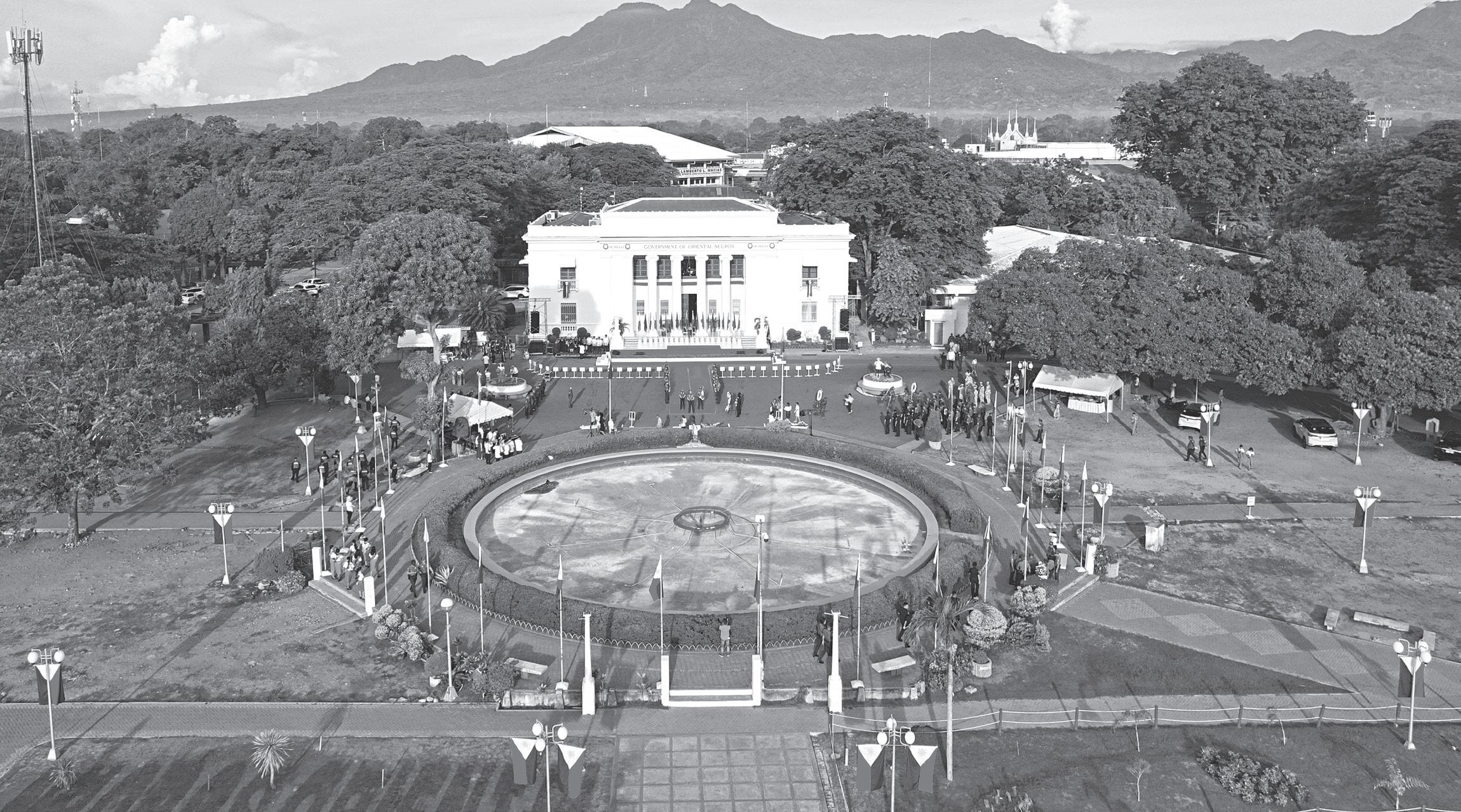
By Bernard L. Supetran
Much like the “Pearl of the Orient” moniker of the Philippines, Negros Oriental is a precious gem of the eastern and smaller part of Negros Island with its natural allure which has made it among the top destinations in the Visayas.
And while at times overshadowed by its more popular neighboring provinces, its glitter as a tourism gem to be discovered has never been diminished.
To put the spotlight to its wonderful blend of nature, adventure and culture, and everything in between, Negros Oriental is throwing for the umpteenth time a grand party, the Buglasan Festival from October 18-27.
Now on its 44th staging, it puts to the fore local pride through artistic talents, tourism, culture, heritage, and natural and agricultural resources, The fest was derived from buglas or Buglas Insulis, the tall marsh grass which grew in abundance across the island and where pre-Spanish period Negros got its name.
“This year’s Buglasan Festival is special, as it serves as a followthrough to the grand centennial anniversary of our neo-classical provincial capitol building early this year where we showcased history and architectural heritage,” says Governor Manuel “Chaco” Sagarbarria.
The Graeco-Roman edifice was inaugurated in 1924 in the capital town of Dumaguete, and is an iconic landmarks along with the land -
scaped greeneries called Freedom Park. The capitol was designed by eminent American-era architect Daniel Burnham, who also did the urban plans for Manila and Baguio.
“This year’s edition is also unique with the recent signing of the Negros Island Region Act by President Ferdinand Marcos, Jr., where the province will be home to some regional offices of key national government agencies,” he added.
Sagarbarria also noted the 191 percent exponential increase in the province’s guest arrivals for the first semester of 2024, compared to same period last year. This growth can be attributed to more focused and aggressive campaign via the Tourism Roadshows across the various municipalities, as well as enhanced collaboration with local industry stakeholders. Themed “Celebrating Dedicated Public Servants, A Resilient and Supportive Constituency, and the Harvest of Progress through Destination Stewardship,” Buglasan recently kicked off with a civic-military parade, opening of the 23 local government unit (LGU) booths, and a variety of entertainment shows. Events will unfold in public venues in the provincial capital of Du -



maguete, popularly known as the City of Gentle People.
Sporting events such as the International Negros Oriental Marathon, the Negros Island Moto-Tour Adventure and a motor show, will further boost the province’s positioning as a sports tourism hub in

the Visayas. In previous years, Dumaguete City has been accorded the Philippine Sports Tourism Award by a Manila-based private alliance for its sports-friendly facilities and government policies.
Scuba divers and underwater photographers will plunge into the

depths of the seabed in the Negros Dive Fest from October 22-27 to showcase the province’s marine biodiversity, which is reputed to be among the richest in the world’s Coral Triangle, particularly in the waters of Dauin and Zamboanguita.
The dive photo contest is also in line with the province’s Ridge to Reef campaign which seeks to strengthen the conservation and protection of its lush upland, coastal and marine ecosystems.
Merry-making reaches fever pitch on October 25 with the Festival of Festivals Street Dancing, the main event where the public will witness the showdown of participating contingents from the cities and municipalities interpreting through colorful dances their local character and identity.
It will be followed by the Festival King and Queen, and Ritual Showdown, to be capped by a music fest around the spruced-up Freedom Park.
The Grand Float Parade on October 26 will brighten up night-time Dumaguete with the mesmerizing lights of the municipal and city floats, followed by the Miss Negros
Oriental pageant which will name the fresh set of ambassadresses of goodwill and tourism.
But beyond all the merry-making, the festival is arguably the best opportunity to visit its well-loved tourism circuit—the famed Twin Lakes of Sibulan, the sandbar of Manjuyod, the Crystal Caves and Spring Pool of Mabinay, and dolphin watching in Bais Bay.
Outdoors lovers can bask in the mesmerizing waterfalls of Casaroro and Pulang Bato in Valencia, and Niludhan in Bayawan, as well as the mountain hideaways in Canlaon City, Pamplona, Dauin, Sta. Catalina and Valencia.
Beach lovers can frolic in the infinite stretch the fine sand beaches of varying color and texture across the coastal communities from Vallehermoso to Basay. Meanwhile, foodies will surely find the province a haven for delicious and inexpensive food in the quaint restaurants, cafes and homey eateries around Dumaguete and roadside towns.
With these and more, Negros Oriental is undeniably a “pearl of the orient” in its own right.


By Malou Talosig-Bartolome
THE European Union Space Agency has started sharing satellite images to the Philippine Space Agency (PhilSA) to help the Philippines in mitigating disasters, such as flooding, landslides, earthquakes, volcanic eruptions, and typhoons, as well as in reducing climate vulnerability, and conserving land and marine biodiversity.
Real-time images captured from EU’s Sentinel satellites are shared to Copernicus Mirror Site for free for the Philippine govern
ment to use.
The National Copernicus Capacity Support Action Programme for the Philippines (CopPhil) is EU’s first bilateral space coopera
tion program with a country outside Europe.
The EU is hoping that this will be replicated in other Asean countries.
“Copernicus is the only Global Gateway space program in southeast Asia. Copernicus opened the door for something more important—it established the foundations of our partnership in the digital sphere,” the new EU Ambassador to the Philippines Massimo Santoro said in his speech at the launch on Thursday.
As one of the richest in bio -
diversity countries in the world, the Philippines can benefit with these data captured from EU’s eyes, Santoro added. Rodolfo Calzado Jr., Science and Technology assistant secretary, said Copernicus offers “highly granular sets of data” that Philippine Atmospheric, Geophysical and Astronomical Services Administration (Pagasa), Philippine Volcanology and Seismology (Phivolcs) and other government agencies may use to provide more appropriate and relevant information that can be shared to the public.
“It can be also be used to protect our businesses, for crop monitoring, resilient infrastructures, critical facilities, such as schools and hospitals,” Calzado added.
Copernicus’ data may also be used in tandem with existing data of the Philippine government, such as in fighting malnutrition and identifying specific location where industries thrive better.
Miguel Angel Exposito, deputy head of Unit Digital Transformation of the European Commission, said under CopPhil, in situ data captured in the Philippines will also be stored in the data center “giving a rich data set that is of mutual benefit for millions of people so we can model climate change on a global scale.”




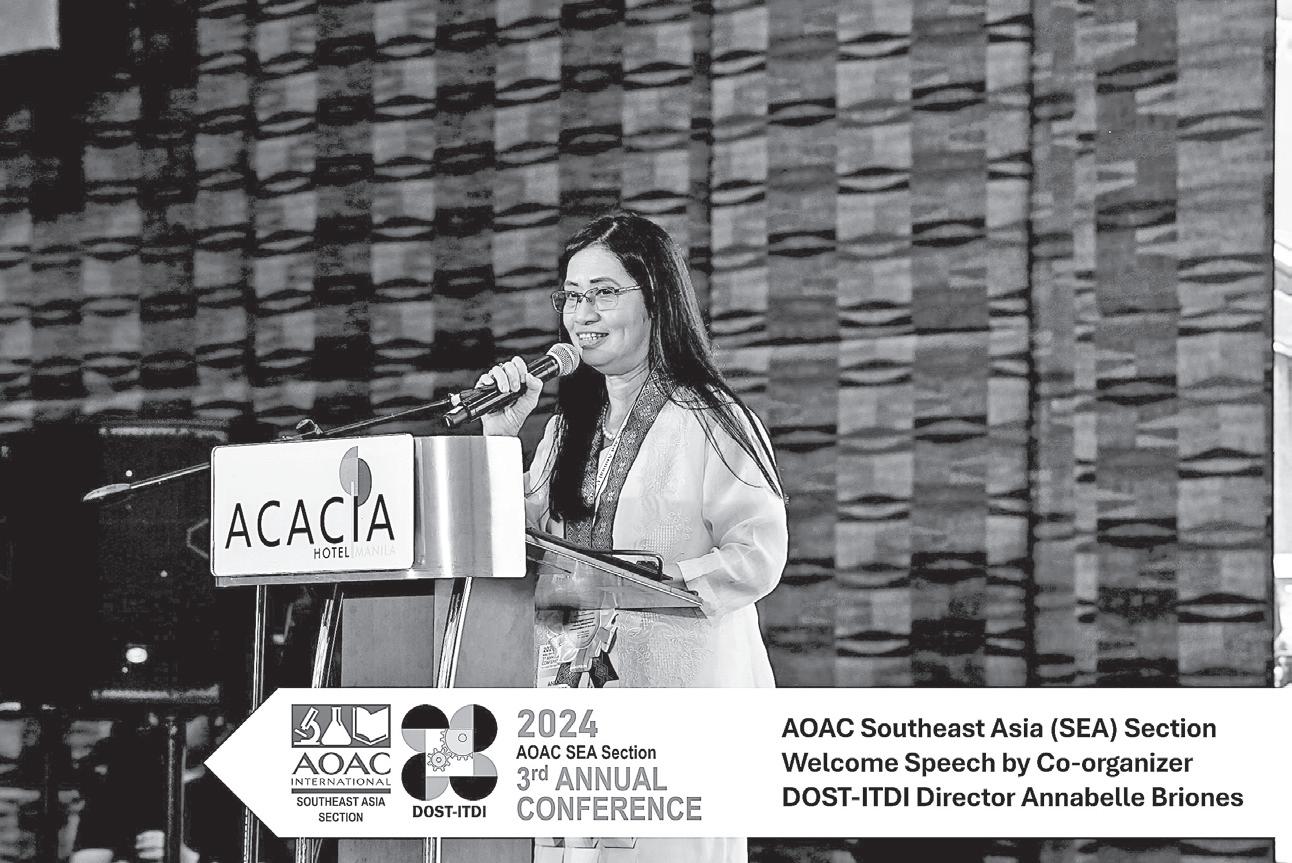
By Geraldine Bulaon-Ducusin
‘FOOD safety is not just a right but a shared responsibility from all stakeholders—academia, industry, government and consumers,” said Science Secretary Renato U. Solidum Jr. as he addressed the participants of the Association of Official Analytical CollaborationSoutheast Asia Section’s (AOACSEA) 3rd Annual Conference on October16 and 17 at a hotel in Muntinlupa City.
The event was hosted by AOAC International SEA Section and coorganized by the Department of Science and Technology-Industrial Technology Development Institute (DOST-ITDI), being a member and leader of the Working Group for Harmonization of Method. DOST-ITDI is led by Director Dr. Annabelle V. Briones.
Though AOAC International was founded 140 years ago in Washington, DC,, the AOAC-SEA was established only in June 2021, including 10 countries—Brunei, Cambodia, Indonesia, Lao PDR, Malaysia, Myanmar, the Philippines, Singapore, Timor-Leste and Vietnam.
The two-day event brought together 20 global and regional experts and key stakeholders.
It featured 33 scientific and high-level presentations related to food safety technologies and assessment methods.
Solidum shared with the participants the initiatives of DOST in terms of food safety, such as the 2023-2028 road map, the various testing laboratories, and the guidelines and protocols it has developed.
“Food safety is very important because every country has their own standards which we have to comply so our products can get to them,” said Rebecca Maniat, assistant director-Trade and Compliance of the Papua New Guinea (PNG) National Trade Office, at the AOAC-SEA Section conference.
While PNG is not yet a member of the AOAC, Maniat attended the conference to learn more about the food safety standards and testing, since her country has been exporting oil and gas, agricultural products, minerals and wood overseas to Europe, the United States, and other countries.
The conference showcased some of the latest technologies that makes methods testing and assessment easier and accurate.
One of the technology solutions is on pathogen testing used to identify pathogenic organisms
THE supply of onions in the Philippines has been dwindling owing to several factors—including low yield owing to infestation—which causes decrease in farmer’s income and high prices.
To help solve onion infestation, science researchers are eyeing the potential of bamboo as an organic pesticide to help control armyworm and cutworm attacking onion plantations.
The Department of Science and Technology’s Forest Products Research and Development Institute (DOST-FPRDI) experts are developing formulations and test the performance of bamboo pyroligneous liquid (PL) in controlling onion armyworm (OAW) and cutworm in local onion farms.
in manufacturing environments, ingredients or finished products that could harm the consumer.
Types of pathogens include specific bacteria strains, viruses, fungi, or parasites that can cause illness in its host.
Another technology is on food labelling and histamine testing solution. Because high levels of histamine can cause food poisoning, known as scombroid poisoning that leads to symptoms like headaches, rashes, and gastrointestinal issues, a device that can directly analyse histamine’s presence in food can help.
In his presentation “Determining Laboratory Competence by Proficiency Testing for Food Microbiological Analysis,” Marlon S.A. Aguinaldo of the Biological Laboratory, Standards and Testing Division of DOST-ITDI, presented the government’s role, from the regulatory bodies, policies, to process and food standards.
From farm, factories, laboratory, distribution, to market, stores and consumers, laboratories are an integral part of food safety systems.
The Emerging Issues Working Group of AOAC-SEA Section aims to identify and monitor emerging issues to forecast and predict
possible food safety risks, and develop appropriate measures to manage the identified risks.
Emerging Issues expert panels cover the following areas: Environmental/Process Contaminants; Inorganic Contaminants/Heavy Metals; Pesticides Residual Analysis; Mycotoxins/Plant Toxins; Allergens; Food Authentication; Rapid Analysis Method/ Biosensor; and Novel or Future Food.
This year, the Section of the Year Award was recognized by the AOAC-SEA Section for facilitating multiple initiatives throughout the year, such as communication across various platforms, recruitment, and service to the association.
There are 15 AOAC Sections that connect analytical communities in the US and worldwide, representing four continents and more than 120 countries.
The sections provide opportunities for participants to share information, build professional contacts, expand leadership skills, and gain practical management experience.
The SEA Section welcomes information from the people of Southeast Asia on the emerging issues and concerns on food safety which they would like the section to tackle.
Science Secretary Renato U. Solidum Jr. expects innovative uses of and products from bamboo through this project.
“The potential of bamboo as a costeffective solution to enhance the local production of high-value crops opens exciting market opportunities for our farmers. The study will not only contribute to enhancing agricultural practices, but is also seen to drive the local bamboo and onion industries to new heights,” Solidum said.
The DOST chief further said that they are “optimistic” that the result of this project
“will provide solution to the challenges in the production being faced by our onion farmers and open new market opportunities for our bamboo growers.”
PL, a by-product of charcoal production, is derived from the collected and condensed smoke during pyrolysis—a process that heats or burns a plant biomass without oxygen. PL acts as a disinfectant, bathroom deodorizer, organic pesticide, and is commonly used in medicine, cosmetics and food processing industries.
Titled “Bamboo Liquor Ph: Local Innovation for Quality Use of Organic Pesticide Resource in the Philippines,” the project is a collaboration with the Department of Agriculture-Bureau of Plant Industry and funded by the DOST-Philippine Council for Agriculture, Aquatic and Natural Resources Research and Development.
DOST-FPRDI OIC Director Rico J. Cabangon said that results of the study can positively affect both the bamboo and onion sectors.
“A cost-effective and more environmentfriendly pesticide from bamboo PL can translate into higher yield and reduced production cost for local onion farmers. It can also open new economic opportunities for bamboo growers who rely mostly on its traditional uses,” Cabangon explained.
According to Project Leader Jennifer P. Tamayo, several formulations of the bamboo PL will be validated in actual farm
setting to test its efficacy, commercial potential, and applicability in minimizing the harmful effects of the cutworm and OAW in onion farms.
Last August 22 a Memorandum of Agreement was signed between DOSTFPRDI and the Rice, Onion and Corn Growers Association for the field validation trials of bamboo PL.
The trials will be conducted in a half hectare (5,000 sq m) land in Sto. Domingo, Nueva Ecija during the next planting season.
The research is part of the “Establishment of Philippines-China Joint Program on Bamboo Research” project with China’s Jiangxi Academy of Forestry.
The initiative marks the agencies’ shared commitment to pursue advancements in bamboo innovation.
Among others, the Philippine-China project will provide technical support for the development of bamboo technologies and
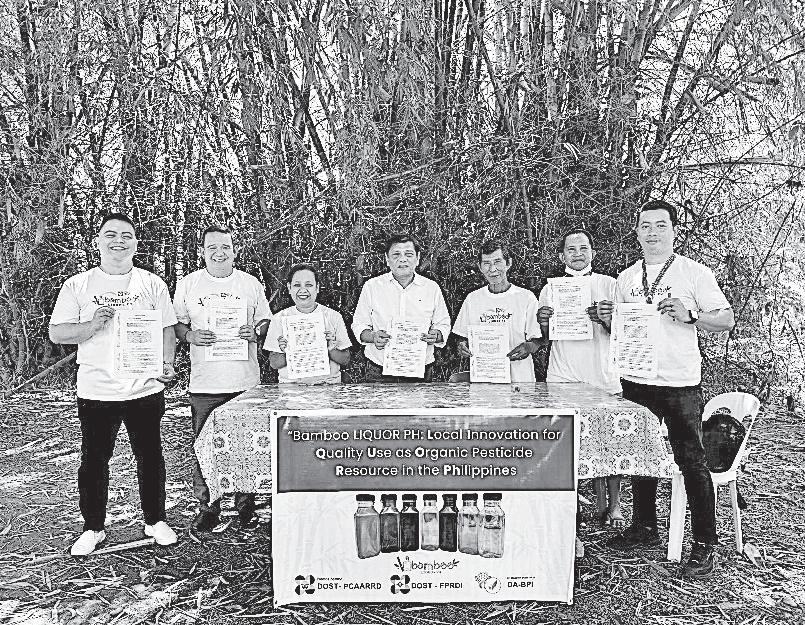
A6 Sunday, October 20, 2024

Editor: Lyn Resurreccion • www.businessmirror.com.ph
IN 2021, Sister Nathalie Becquart became the first woman to vote at any Vatican meeting when Pope Francis appointed her undersecretary to the synod, a gathering of bishops whose second session opened on October 2.
Becquart is, in the words of Catholic media, “the synod’s face and voice,” even “a synodal icon.”
She describes “synodality” as “like having a coffee together”— encouraging many Catholics to hope that their church will reimagine itself in less hierarchical ways. With her appointment, Cardinal Mario Grech, the synod’s secretary-general, remarked: “A door has been opened.”
Grech did not mention it, but Catholic women have been knocking on this door for over a century.
Becquart and the synod’s 53 other female participants, both lay and religious, follow a long line of Catholic women who have cogently, and often critically, analyzed church governance.
At the current synod, whose purpose is to address “communion, participation, and mission” in the church, women’s role is on the agenda.
But Catholic women have historically found ways to speak to and about their church leadership, even when they have been excluded from its proceedings.
Uninvited guests
IN 1869, when Pope Pius IX convened the First Vatican Council, no one dreamed of inviting women, but they were nonetheless there.
Vatican I was the first churchwide meeting of bishops since the Reformation.
Its most momentous—and
controversial—result was the proclamation of papal infallibility, sealing the church’s view of itself as an absolute monarchy.
Critics both within and outside the church condemned the assertion that the pope alone, without the counsel of bishops, could determine doctrine.
Women who witnessed the council, especially those who published accounts of the event, were eloquent critics of this top-down church.
Many well-educated and wellconnected laywomen traveled to Rome in 1869 to witness their church set its future direction. They hosted salons where bishops exchanged news in the evenings after council sessions. They corresponded with absent friends and were nodes in a network of Catholics who opposed infallibility.
When the German priest Ignaz von Döllinger wrote a devastating critique of infallibility from his study in Munich, he relied in part on information forwarded from Rome by his friend and protegée, 27-year-old Charlotte von Leyden. Outliving the council fathers of Vatican I, she got the last word in 1907, when she published the chapter on papal Rome for the landmark “Cambridge Modern History.”
The conservative Catholic press relentlessly mocked these women as misguided busybodies.
Vatican I sidelined the laity

THE Vatican announced recently that Pope Francis has established the new Diocese of Prosperidad in the Agusan region and appointed its first bishop, Ruben Labajo, who until now is auxiliary of the Archdiocese of Cebu.
The new diocese, which comprises the province of Agusan del Sur, was carved out of the 57-yearold Diocese of Butuan, which now covers only Agusan del Norte.
The pope’s decision to split the Butuan diocese into two stemmed from a petition filed by Bishop Cosme Damian Almedilla of Butuan in 2023. Almedilla had previously described the division as a “strategic move” to foster the spiritual growth of the faithful and to improve administrative efficiency within the respective dioceses. He also referred to Agusan del
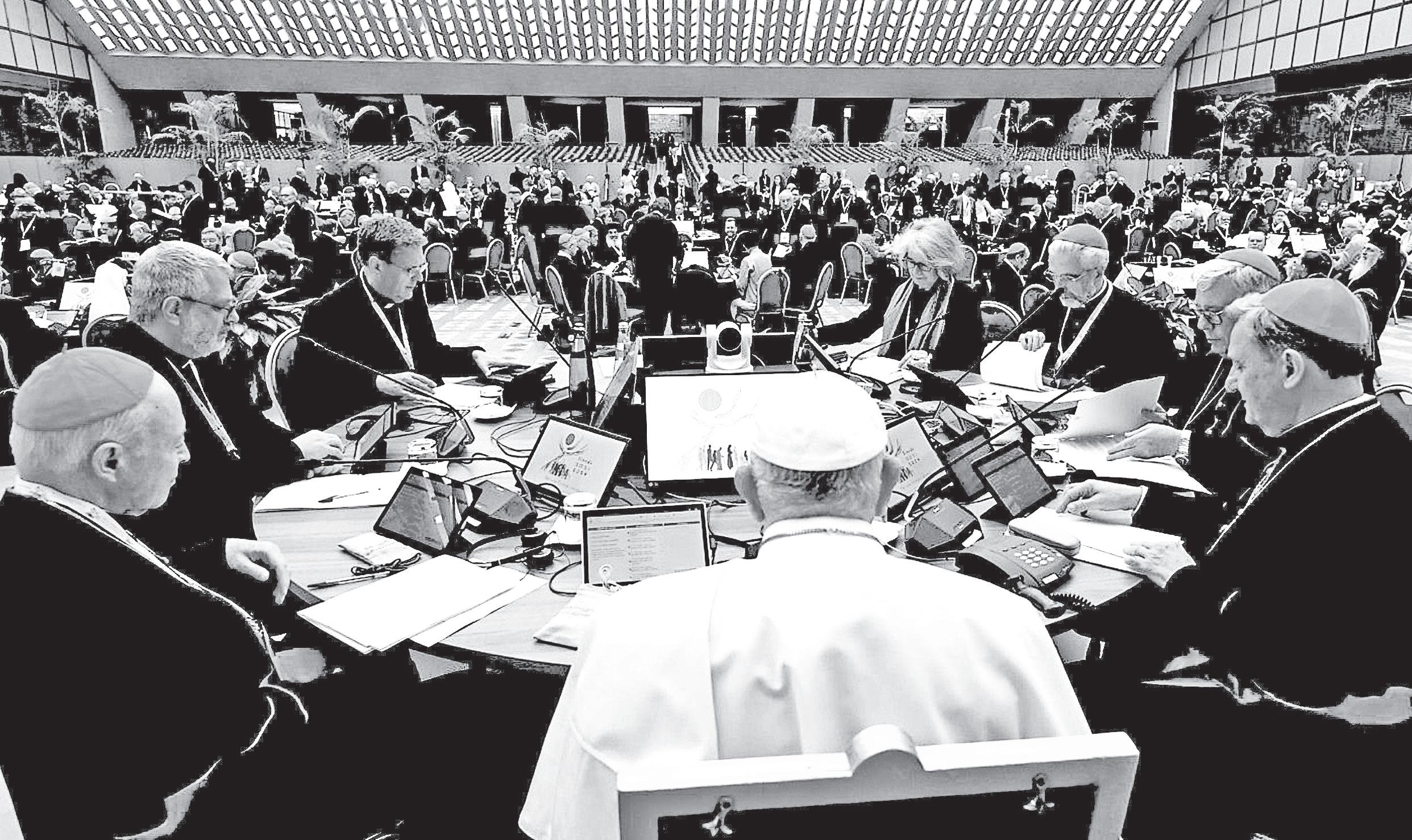
of both sexes, but women who claimed a voice in church affairs seemed especially impertinent to the bishops who endorsed infallibility.
Violating St. Paul’s injunction that women be silent in church, they defied clerical authority and the logic of a church that spoke with only one voice.
Change comes slowly to Vatican II
VATICAN II began in 1962 much like Vatican I: an all-clerical, allmale assembly.
Women initially sought influence in similar ways as well. Every night the Belgian journalist Betsie Hollants made a pot of soup and held open house for the council fathers.
Soup broth and red wine were cheap, she recalled, but they made for convivial gatherings that kept her informed about the council.
Responding to women’s request to participate formally, however, one dismissive cardinal reportedly suggested that they should “try again at Vatican III or IV.”
As the council proceeded, the absence of women seemed increasingly incongruous.
Douglas Horton, an American Protestant pastor invited as an observer, noted the “air of artificiality” of an assembly without women.
By the second session in 1963, Mildred Horton and other nonCatholic observers’ wives could attend some events, but no Catholic women were present.
When the Catholic press corps received Communion, a Swiss Guard physically prevented the only female journalist from approaching the altar.
Pope John XXIII had declared “aggiornamento”—bringing the church up to date—the order of the day, but these incidents made many wonder if aggiornamento was possible without women.
Signs of change arrived at the fourth session in September 1964, when the new pope, Paul VI, appointed 23 women auditors: 10 religious and 13 lay women.
They participated in preparatory sessions, especially those con -
cerning the laity, where they were, in Paul’s words, “experts in life.”
No woman ever addressed the council fathers; their efforts to do so were rebuffed, but their presence in preliminary meetings was significant.
In a discussion of marriage, for instance, Luz María AlvarezIcaza—a Mexican woman who, with her husband, José, was an auditor—informed the assembled clerics that she was confident that their mothers had conceived them in acts of love, not animal lust.
One of the most significant changes to emerge from Vatican II was the reassessment of marital sex.
Whereas the church once viewed sex between husband and wife as a check on humanity’s essentially sinful nature, new teachings described it as a positive expression of love.
More than ‘flowers and light’
THE documents produced by Vatican II say relatively little about women, which was, arguably, a victory for female auditors. Many
of them mistrusted the council fathers’ view of women as a separate, even foreign, species.
The Australian theologian Rosemary Goldie, listening to the eminent French theologian Yves Congar’s extravagant descriptions of women’s role, told him, “You can cut the references to women as flowers and light.… We don’t need any of that grandiose stuff.… All we want is to be treated as full human beings.”
“Women are not ‘a category’ in the church,” Sister Mary Luke Tobin, an American, maintained: “Men and women are the church.” Thanks to these 23 “mothers of the council,” Vatican II’s teachings on women are, for the most part, incorporated into its larger treatment of human dignity, not segregated into separate chapters on women’s nature.
Possibilities today
HOW much will it matter that 54 voting women have replaced the hostesses, writers and auditors of Vatican I and Vatican II? We probably won’t know for a long time— decades at least. Revolution is unlikely. Many Catholics support allowing women to serve as deacons—ministers who can perform some, but not all, of the priest’s duties. That possibility, however, is off the synod table, handed to a commission for further study. The ordination of women as priests seems impossibly distant. It could be, however, that 54 female voices teach their church how to speak of and to women as equals. Or it may be that those voices disappear amid the cacophony of nearly 400 participants.
As Pope Francis reminds both conservatives and progressives, the synod is not a parliament. Votes are counted, but as a step toward discernment of truth, not a moment of decision. Carol E. Harrison, University of South Carolina/The Conversation (CC) via AP
A realistic statue of Mary giving birth was criticized, vandalized
ASCULPTURE of the Virgin Mary showing her giving birth to Jesus was recently attacked and beheaded.
Called “Crowning” by the artist Esther Strauss, the sculpture had been part of a temporary exhibition of art outside the Catholic St. Mary Cathedral in Linz, Austria.
The sculpture was controversial for its explicit depiction of birth; an online petition seeking its removal received more than 12,000 signatures.
Sur as a “missionary frontier,” noting its far-flung communities spread across the landlocked and mountainous province. About one-third of the province’s population are indigenous peoples, the bishop added. Prosperidad will be the country’s 87th diocese and will be a suffragan of the Metropolitan Archdiocese of Cagayan de Oro.
The diocese has a population of nearly 800,000, of whom around 486,000 are Catholics spread across 26 parishes, 1 quasi-parish, and 3 mission stations. It also has 32 diocesan priests, 29 religious priests, and 6 sisters. Labajo, 58, was ordained priest for the Cebu archdiocese on June 10, 1994.
In June 2022, Pope Francis appointed him as auxiliary bishop of Cebu. He was ordained to the episcopate on Aug. 19, 2022. Roy Lagarde
Strauss’ work was part of a project that sought to look at gender equality and the role of women, designed to honor the 100th anniversary of the cathedral’s consecration to the Virgin Mary. The exhibition opened on June 27, and the statue was vandalized a few days later.
My research as a historian of art has shown me that there has never been only one way of depicting the birth of Christ.
Depiction of birth in early texts
Early Christian writings reveal that the birth of Christ was of keen interest and reflected ideas of the day.
A widely read text from the mid-second century, called “The Protoevangelium of James,” gives details about the life of the Virgin and infancy of Christ.
As women of that time gave birth with the aid of midwives, the text explained that the Mother of God also was helped in her labor.
Sections 19-20 of the text give details about Joseph contacting two midwives.
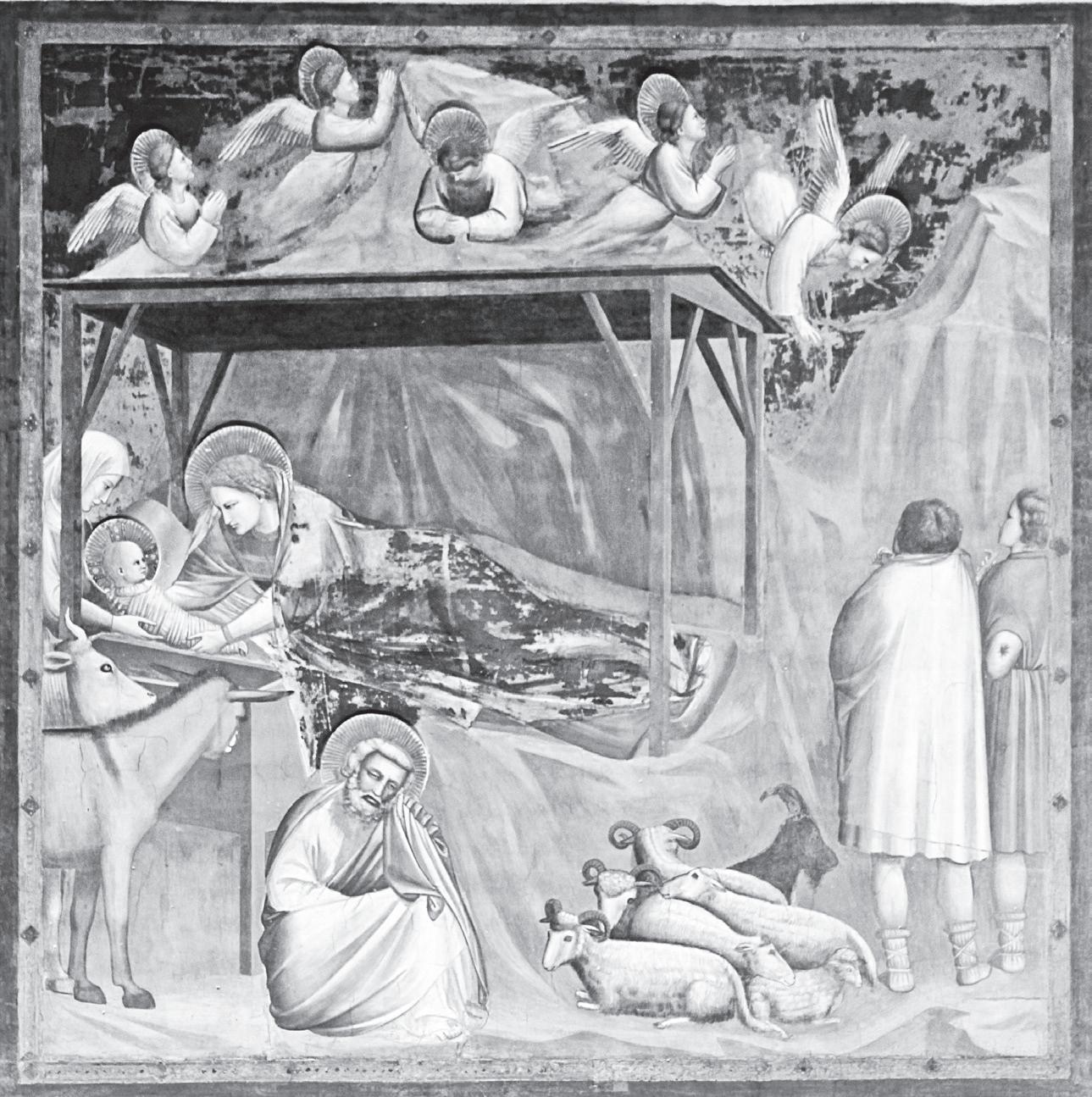
One woman is said to have doubted the virgin birth. After she inserted her finger into Mary’s vagina, her hands withered.
An illustration in a French prayer book from Paris dating to about 1490-1500 shows the midwife with missing hands.
The story explained that her hands grew back after she touched the child Christ.
The representation of midwives, as seen in an 11th-century manuscript from Constantinople, is still common in the Eastern church.
Ideas change over time and place
NEW modes of spirituality in later centuries brought changes in art.
St. Bridget of Sweden, who founded a new order of nuns, left a large body or writing, including what she believed were revelations from God. One of her revelations included a vision of Christ’s birth she experienced in Bethlehem in 1371–72.
Although Bridget had given birth eight times, she described Mary’s delivery as “in the twinkling of any eye.” Bridget said she “was unable to
notice or discern how or in what member [Mary] was giving birth.” By “member” she may have meant that she did not know through what part of Mary’s body Jesus emerged.
Many paintings between the 15th and 16th centuries adopted her vision and showed the child surrounded by light and the Virgin calmly worshipping him.
A painting by Belgian artist Hugo van der Goes, in about 1475, follows Bridget’s vision of the birth.
Instead of being “wrapped in swaddling clothes,” Christ lies naked, perfectly clean, in the “great and ineffable light” that Bridget described. Each era and community produces art that speaks to its own priorities.
Fifteenth-century Italy introduced traditions of a miraculous childbirth that were different from a realistic tradition cherished by early Christians of the second century. I would argue that “Crowning” is but one more example of such cultural change. Here, Mary is an inspiration for other women, physically strong and capable even in the difficult process of giving birth.
The sculpture, when intact, was barely 15 inches tall, a clear indication that it was not made for large-scale public veneration. It was a meditative image designed for a one-on-one encounter—for those who decided to engage. Virginia Raguin College of the Holy Cross/The Conversavtion (CC) via AP

Editor: Lyn Resurreccion

MSMEs commit to go plastic-free, tie up with Greenpeace, DTI-NCR
AGROWING number of micro, small and medium enterprises (MSMEs) are determined to show big companies that greening the manufacturing and retail sector should be everyone’s business.
In an event titled “Reduce, Reuse, Refill: 3Rs to End Plastic Pollution,” environmental advocates, the Department of Trade and Industry (DTI) and progressive business groups joined MSMEs to reduce their production and consumption of single-use plastics (SUPs) and adopt more sustainable practices.
The initiative aims to build the capacity of MSMEs to lead the shift toward environmentally responsible business operations.
It led the MSMEs to hold on Tuesday a field immersion and discussion at the Las Piñas-Parañaque Wetland Park (LPPWP) to raise awareness among local businesses about the destructive impact of SUPs on ecosystems and communities.
The LPPWP, which is home to over 41 migratory bird species and the threatened and endemic Philippine duck, faces severe threats from plastic pollution.
“Small businesses are doing their part in decreasing reliance on single-use plastics, and are proving that it is possible,” said Marian Ledesma, Zero Waste Campaigner for Greenpeace Philippines. “There’s no excuse for major corporations not to follow suit.”
MSMEs comprise 99.59 percent of all business establishments in the country.
According to Ledesma, this considerable number of MSMEs plays a pivotal role in sparking changes in the industry.
“This includes transitioning prevailing business models away from SUPs and influencing consumers in their respective communities,” she added.
Participants in the event included fisherfolk, community members, and waste workers, who shared firsthand experiences of how plastic pollution affects food security, environment and livelihood.
Over 164 million plastic sachets and 57 million shopping bags are discarded every day in the Philippines, much of which are not recycled. They end up in landfills or waterways, contributing to pollution and the climate crisis.
“Plastics destroy our fishing gears and drive away the fishes that means more gasoline expense for us. They also cover and kill the areas where fishes lay their eggs, the corals, mangroves and marine plants,” said Pangisda Pilipinas Chairman Pablo “Ka Pabs” Rosales
He called upon environmental businessmen to lead against the use of single-use plastics.
“Please support the initiatives of fishermen in cleaning the coastal areas and the oceans so that abundance and green environment will return,” Rosales added.
Upstream solutions such as reduction, reuse and refill are aligned with the DTI’s Green Economic Development program. These approaches aim to enhance MSME competitiveness by helping businesses adopt climate-smart, environmental-friendly, and inclusive strategies.
“Sustainability is our only option for a better tomorrow; it is a crucial aspect of business resilience and long-term success,” said DTI-National Capital Region OIC-Regional Director Winston T. Singun.
“There are no businesses to speak of in an inhospitable future, plagued with various environmental crises. MSMEs have the power to make a positive impact not only in our economy, but also our planet,” Singun added.
They had a nature walk and sustainability discussions in Talyer 15 at the Henry Hotel Compound led by business owners championing sustainable plastic reduction efforts.
They featured entrepreneurs and communities who have successfully employed viable, practical, and innovative alternatives to plastic use, paving the way for a just zero waste transition.
Leading the charge in the “Greening Your Business” discussions are speakers from Back to Basics Ecostore, Newport World Resorts, San Juan Resort Restaurant and Hotel Association (La Union) and Rizza Lana Sebastian.
The panelists shared their expertise on how to “green” the supply chain, how to reduce plastics in tourism, and how to practice sustainable communications.
Reuse and refill solutions such as those applied by Kuha sa Tingi (Greenpeace Philippines), JuanaZero (Mother Earth Foundation), Sabon Express, and Good Food Community were also tackled to mitigate the crisis.
The field immersion and sustainability discussion is an initiative under “Champions of Change,” a growing global collective of forward-thinking businesses committed to transitioning towards a plastic-free future.

TWO years after reaching a historic biodiversity agreement, countries will gather this coming week to determine whether they are making progress on efforts to save Earth’s plant and animal life.
The agreement signed by 196 countries at the United Nations Biodiversity Conference calls for protecting 30 percent of land and water by 2030, known as 30 by 30.
When the agreement was signed, 17 percent of terrestrial and 10 percent of marine areas were protected—which hasn’t changed significantly.
At the conference known as 16th Conference of Parties (COP16), countries will report on progress made toward the goals, and governments are expected to agree on mechanisms to assure the implementation of them, according to a European Parliament report.
The two-week meeting in Cali, Colombia, will also focus on efforts to raise hundreds of billions of dollars to protect nature by 2030—with the payment of $20 billion for developing countries due next year.
Twenty-three targets will be discussed including cutting food waste and preventing the introduction of invasive species.
Signs of progress hard to find THE nearly 200 countries are supposed to submit national plans ahead of the conference showing actions they are taking to meet the 30 by 30 goals.
But as of the past week, around 46 percent of countries have submitted targets and less than 15 percent submitted plans for reaching them.
Australia has yet to submit its targets, while India has not submitted a national plan. Brazil, which includes much of the Amazon rainforest, hasn’t submitted targets or a plan.
The United States, which is not party to the biodiversity convention, is not required to submit any plans. But the Biden administration has committed to protecting a third of American land and waters
by 2030.
Some countries are expected to use the conference to unveil plans for creating or expanding protected areas and for how they’ll spend biodiversity funding.
Canada, for example, has committed to spending $800 million on four Indigenous-led projects.
Conservation groups are concerned that more countries have not yet detailed their biodiversity goals and how to achieve them.
Bernadette Fischler Hooper, head of global advocacy for WWF International, called the commitments so far “disappointing.”
WWF, which is tracking the progress, also found some plans lack actions to halt biodiversity loss, funding to support efforts and sufficient buy-in from across government.
“This is really, really getting close,” Hooper said. “There are some countries who can easily afford to update [their plans]. There’s no reason why they didn’t do it... and there are countries that didn’t get the support they needed.”
Of the 91 countries that submitted targets, the convention’s secretariat found more than half had targets of protecting and conserving at least 30 percent of their terrestrial area and about a quarter had targets for 5 percent to 30 percent.
For marine and coastal areas, more than one-third had a national target of 30 percent or more, and another third had targets between 5 percent and 30 percent.
But Astrid Schomaker, executive secretary of the Convention on Biological Diversity, said the small number of countries submitting plans isn’t surprising since governments first had to come up with targets and then develop action plans.
“These are complex processes that are meant to be a whole of government,” she said of the plans

that require coordination and buyin from ministries, business leaders and community stakeholders, as well as raising money.
“That’s not happening overnight.”
Achieving the targets is especially critical to migratory species, more than 40 percent of which a UN report found are declining.
“Birds do not recognize boundaries of a protected area and move according to their feeding and roosting needs,” said Jennifer George, who leads the Seoul-based East Asian-Australasian Flyway Partnership, a nonprofit focused on birds migrating between East Asia, Australia and New Zealand.
Funding crunch
MUCH like the UN climate talks, a big topic of debate at the biodiversity conference will be financing.
Poor countries pushed to include language requiring that $200 billion a year be raised by 2030 for biodiversity from a range of sources to fund the target-specific projects.
Rich countries committed to providing developing countries $20 billion starting next year and gradually scaling that up to $30 billion by 2030.
The Organization for Economic Cooperation and Development reported in September that development finance for biodiversity more than doubled from 2015 to 2022.
But when it comes to funding for this agreement, the world was still 23 percent short of the $20 billion goal.
Advocates said money will be critical since much of the biodiversity that needs protecting is in developing countries like those in Africa.
“There has been progress. Is there enough progress? No,” said Susan Lieberman, the vice president of international policy at Wildlife Conservation Society.
“Some countries are taking it seriously and other countries are saying, ‘Oh we want to do this, but where’s the money?’” she said.
More than 30 by 30 IN addition to top-tier biodiversity targets, the conference will discuss a goal in the agreement to halt human-induced extinction of threatened species and, by 2050, to reduce extinction rates tenfold.
The goal also calls for increasing the “abundance of native wild species” to healthy levels.
But conservationists say the goals lack specifics and hope details can be agreed upon at the meeting.
“Many of these other targets need to be nailed down and quantified, like stopping species extinctions,” said Duke University ecologist Stuart Pimm. “At the moment, they are terribly vague.”
Countries plan to showcase the role biodiversity plays in achieving climate mitigation goals and in health, especially preventing future pandemics.
The meeting will also consider adoption of a global mechanism for sharing of benefits from digital data from genetic material derived from plants, animals, bacteria and viruses.
The materials are ften used to developed commercial products like drugs—and the hope is that an agreement will ensure profits are shared equitably. Michael Casey & Christina Larson/ Associated Press
HOLCIM Philippines Inc., a leading building solutions provider, recently earned its first Golden Arrow Award.
The award is given to companies for good practices based on the Asean Corporate Governance Scorecard (ACGS) and the Corporate Governance Scorecard. Companies receive the Golden Arrow Award for observable conformance to the Philippine Code of Corporate Governance and internationally recommended corporate governance practices espoused by the ACGS.
The Institute of Corporate Directors PH conducts the assessment using an 184-question scorecard based on publicly available disclosures on a company’s website.
Nicolas George, president and CEO of Holcim Philippines, said: “We are grateful for this recogni -

nies in the country. It has a deep portfolio of innovative solutions fostered by a full range of products from structuring to finishing applications that can help local builders execute with high performance and efficiency a wide range of projects from massive infrastructure to simple home repairs. It has cement manufacturing facilities in La Union, Bulacan, Batangas, Misamis Oriental and Davao, as well as aggregates and dry mix business and technical support facilities for building solutions. Holcim Philippines is committed to the highest standards of sustainable operations and manufacturing excellence with its plants certified under ISO 14001:2015 (Environmental Management
MANCHESTER, England—The rising number of injuries to top soccer players came at a cost of nearly $800 million to teams across Europe’s leading leagues last season, according to a report published Tuesday.
At a time when there are growing concerns about the number of games players are being asked to play, the Men’s European Football Injury Index found there were 4,123 injuries in the top divisions of England, Spain, Germany, Italy and France in the 202324 campaign.
The cost of the injuries was based on the reported salaries of the players concerned and the amount of time they were sidelined for.
The report highlighted a greater strain on clubs as a result of the newly expanded Club World Cup, which will be staged in America next year.
The number of injuries has risen year-on-year since the index was first published in 2021 and the latest report said “it would be fair to expect a continuation of this upwards trajectory.”
“The squad depth of clubs will continue to be tested, particularly with the impending introduction of the new FIFA Men’s Club World Cup in 2025.”
The index is produced by sports insurance firm Howden. Its publication comes a day after a players union and European leagues filed a formal complaint to the European Union against world governing body FIFA.
The 32-team Club World Cup—up from seven—has faced consistent pushback over concerns about player welfare since its new extended format was announced last year.
Last month Man City midfielder Rodri said players were close to going on strike in the face of increased demands on them—including an expanded Champions League this year. The Spain international suffered a season-ending knee injury days after those comments.
The football index has tracked a rise in injuries even before the expanded Club World Cup and Champions League. It said there had been 14,292— excluding Covid-19—in the top five European leagues dating back to the 2020-21 season. That came at a cost of $2.5 billion based on the reported salaries.
Last season alone the figure was $798 million.
On average there was an injury every 92 minutes of football involving teams across those leagues. It found that German teams suffered the most injuries per game (1.72). German teams also made up the top 13 places in terms of injury susceptibility and accounted for 15 of the top 20.
Of the teams least susceptible to injury, the top four were all from the French league.
The report said there was a “concerning trend” surrounding players under the age of 21, who were sustaining an increase of severe injuries.


BILLIARDS superstar Rubilen Amit and boxing champion Melvin Jerusalem were at the forefront of Philippine sports in a September to remember.
Further cementing her status as queen of pool, Amit captured the World Pool Association World Women’s 9-Ball Championship with a gutsy 1-4, 4-2, 4-2, 4-3 victory over China’s Chen Siming in Hamilton, New Zealand.
LBy Maria Cheng AP Medical Writer
ONDON—No pain, no gain, as the old exercise adage goes. But just how much pain do you have to endure to benefit from weight training? That depends on what you’re trying to accomplish, fitness experts say.
For years, some trainers have instructed gym-goers that to get the best results, they need to train “until failure,” meaning until you cannot physically do one more repetition or exercise. Some recent studies, however, suggest this extreme regimen, when applied to weight training, may only benefit certain people.
“If somebody wants to increase muscle mass as much as they possibly can, then training to failure is something to consider,” said Michael Zourdos, chair of exercise science and health promotion at Florida Atlantic University, who co-authored a review

MANCHESTER City’s Rodri is down on the pitch injured during his team’s English Premier League match against Arsenal at the Etihad stadium in Manchester, England, last month. AP and energy drink giant Red Bull will come aboard with a minority stake.
France’s richest family Arnault causes major shakeup in soccer FRANCE’S richest family, the Arnaults of luxury empire LVMH, announced the planned purchase of second-division soccer club Paris FC and ambitions to establish it in the top flight. It’s a major shakeup for soccer in France, putting vast wealth behind a potential challenger in the French capital to the dominant Ligue 1 team of recent years, Qatar-funded Paris Saint-Germain (PSG).
A statement from the Arnault family’s holding company, Agache, said it will become the club’s majority shareholder
The statement didn’t give a monetary figure for the deal, which remains subject to completing legal and other paperwork. But the billionaire family’s company intends to provide the club “with the necessary resources” and wants “to permanently establish the men’s and women’s teams among the elite of French football and within the hearts of the Parisians.”
More broadly, the takeover of the club with a distinctive blueand-white Eiffel Tower logo could help the French capital build on the
sporting momentum of the Paris Olympics and put an end to its place as something of an oddball in the European soccer landscape.
Despite being a powerhouse of fashion, finance, luxury and entertainment, Paris trails London, Madrid and other cities by having just one top-flight soccer team: The hegemonic PSG.
The former club of superstar Kylian Mbappé is a 12-time champion of Ligue 1, with 10 of those titles in France’s top league coming after gas-rich Qatar began injecting its wealth into the club it purchased in 2011. AP
Jerusalem dominated previously unbeaten Mexican challenger Luis Castillo to win by unanimous decision and retain the World Boxing Council minimumweight belt in front of a rabid hometown crowd in Mandaluyong City.
In giving the country two world titles in a four-week period, Amit, a two-time world 10-ball titlist, and Jerusalem, one of only two Filipino world boxing champions to date, earned the recognition as the Philippine Sportswriters Association’s top achievers for September. Their feats were complemented by shining performances in
various fronts.
There’s Carlo Biado, another pool star, who reigned supreme in the Ho Chi Minh 9-Ball Open in Vietnam, as well as Johann Chua, who ruled the Zen&Yuan8 9-Ball tournament in Shanghai, China.
Add weightlifters Angeline Colonia (women’s 45 kgs) and Lovely Inan, future Hidilyn Diazes who snared two gold medals and a silver each in the International Weightlifting Federation World Junior Championships in Leon, Spain.
The Philippine women’s team of Woman Grandmaster Janelle Mae Frayna, Woman International Masters

Jan Jodilyn Fronda and Bernadette Galas and Woman Fide Masters Ruelle Canino and Shania Mae Mendoza won the gold medal in Category B of the 45th World Chess Olympiad in Budapest, Hungary.
Daniel Quizon, only 20, also became the country’s 17th GM—the first since 2011—after his stellar play in the same Olympiad in Budapest. And there’s also pro fighter Charly Suarez, who hammered an impressive third-round technical knockout win over Jorge Castaneda in Arizona to claim the World Boxing Organization international junior lightweight title to move closer to his world title dream.
For the average person simply looking to increase their fitness levels, Zourdos said it’s much easier to get results. He said people who work out regularly would benefit from an intense session that comes within five to 10 repetitions of failure, rather than training to complete exhaustion.
He also said “failure training” often comes at a cost, since people working to that standard might be so tired and sore that they skip their next gym session or two.
In extremely rare instances, overdoing it can be harmful, leading to a potentially fatal condition called rhabdomyolysis, where damaged muscles begin to break down, possibly causing kidney damage.
James Fisher, a sport science expert and consultant in Southampton, England, said the idea of working until complete exhaustion can be a turn off for many people.
“What we’re really talking about is how hard you should work when you go to the gym,” he said, adding that the concept should be interpreted to mean that people can spend less time in the gym—if they work hard.

ATHMANDU, Nepal—A
KBritish mountaineer who set the record as the youngest female to climb all the 14 tallest mountains in the world said Thursday that inexperienced climbers should not be allowed to climb the highest peaks because they run the risk of endangering their lives and others.
Adriana Brownlee, 23, climbed Mount Everest at 20 in 2021 and earlier this month climbed Mount Shishapangma in China, completing her endeavor to scale all 14 peaks over 8,000 meters (26,247 feet) high.
She said she has seen numerous climbers who lack training in basic skills and in coping with the unpredictable slopes of the high peaks.
“I have seen many examples of people in the mountains that should not really be there, that should have more training beforehand,” Brownlee told The Associated Press on Thursday in Nepal’s capital, Kathmandu. “We have had to support them and have had to help with like small things like how to put on crampons, how to put on harness.”
She said mountaineering authorities should ensure that climbers attempting to scale the highest peaks have at least climbed smaller mountains to ensure they can handle the
altitude and have the proper skills.
Brownlee flew to Nepal this week alongside other climbers from Tibet including Nima Rinji Sherpa, who at age 18 is now the youngest person to climb the 14 peaks. There are generally no rules besides age restrictions on people who want to climb mountains as long as they are able to pay their permit fees. In Nepal, climbers need to be at least 16 years old. Brownlee said she was just 8 years old when she began dreaming of becoming a mountaineer like her father, who she said was her main inspiration.
She said she now wants to scale unclimbed peaks in Nepal and explore mountains in other parts of the


How a tiny Caribbean island turned the AI boom into a digital gold mine

The singer brings on vibrant musical energy at the Music Museum with her chosen tribe of musicians and artists
Story by Francine Y. Medina
THE Katutubong Diva will finally have her major concert this year.
Billed as “Bagong Umaga,” it will be staged on October 26, 8 p.m. at the Music Museum.
But contrary to an early report, Bayang Barrios’ forthcoming concert won’t be a repeat of her “Katutubong Diva” show held last year at the Cultural Center of the Philippines—that was directed by the late multi-awarded playwright and director Floy Quintos who also gave the singer her moniker.
“I’m nervous but proud,” she told the BusinessMirror, in a refreshingly candidly manner. “It’s the first time that a ‘lumad’ will be performing at the Music Museum. It will be a celebration for sure, of the years I’ve been in the industry. So, expect the concert to be a mix of songs to reminisce on, to feel good, and to dance to.”
As the month of October is National Indigenous Peoples Month, Barrios is also encouraging people to show up in their tribal best.
Further boosting infectious tribal vibe is her long-time band, Naliyagan (or ‘chosen ones” in “lumad”) consisting of Andrew Barrios as musical director; Yan Cruz, bass; Jape Bongat, kulintang keyboards, Matt Bravante, drums; Budeths Casinto, darbuka and small percussions.
For the concert, Abby Clutario is also its musical director and guest musician. Besides being a vocalist and composer, Clutario is a well-known Chapman Stick player.
And imagine the musical energy in Barrios’ concert with guest artists Bituin Escalante, Dong Abay, and Poppert Bernadas. Joining them are the Biñan Metropolitan Chorus and the Biñan Folkloric Dance Troupe. The show is directed by BJ Borja and produced by B-Creative Multimedia Production.
“I BELIEVE it’s destiny. This show and the venue are really meant for me,” Barrios said.
After her successful “Katutubong Diva” concert, which was a celebration of her 35th anniversary in the music industry, Quintos was already planning for her second concert supposedly to be mounted and directed by
him this year. But, he passed on last Aoril.
“I didn’t think of it after that,” Barrios admitted. “I was just saddened by his loss.”
But as destiny would have it, Borja (who also worked regularly with Quintos) learned about Barrios’ planned concert and helped make it possible. Borja is a theater artist, educator, and a top tourism officer in Biñan. Barrios said that she and Borja are aligned with their advocacy in promoting local arts and culture. And with Borja’s expertise, expect an evening of movement and visual delights as well.
BARRIOS is an accomplished artist who has received awards for her vocal talent, expressive renditions, and her relentless effort in promoting indigenous culture through her style and use of native musical instruments. Among her popular songs are “Malayo Man, Malapit Din,” “Bagong Umaga,” and the “Encantadia” theme song. She is also the third member of the Tres Marias singing group consisting of music icons Lolita Carbon and Cooky Chua.
Last September, Barrios received the Fr. Theodore Daiglre Awards for Mindanao Culture and Assrts. The accolade was given to her during the Ateneo de Davao University-Special Convocation for The University Traditional Awards in Davao.
“Of all the awards I’ve received, I feel it is the one closest to my heart because it’s a validation of all the work I’ve been doing in helping spread awareness about the rich culture and concerns of our indigenous people,” she said. “I’ve had a lot of heartbreaks trying to make it in the industry and this award is a validation of my passion, too.”
Born and raised in Mindanao, Barrios is a member of the Manobo tribe who first caught the public’s attention in the early 1990s as a member of Joey Ayala’s Bagong Lumad, She was in her 20s then, a fresh college grad, who left her hometown in Bunawan, Agusan del Sur to join Ayala in Manila to spread a new sound, which synergized ethnic beats with pop music and lyrics with socially relevant themes.
Barrios embarked on her solo career in 1996 via the album, “Bayang Makulay.”





Music and purpose
WHILE this year has been a season of veteran OPM artists holding their farewell and reunion concerts, Barrios is just about to start a new era in her career, She has an album waiting to be launched within the year (meanwhile, songs are dropping one at a time on YouTube and Spotify).
The album, titled “Panukad” (“starting point”) consists of songs penned by her and likewise with her husband and cocollaborator Mike Villegas.
As the wave of P-Pop and K-Pop remains strong and current, Barrios stays afloat by sticking calmly to her brand of music. “My goal now is to continue encouraging the young generation to go back and appreciate our roots, our indigenous culture. There’s nothing wrong with appreciating these trending music but it’s also good to have the music that I carry as a reminder of our past, our story, it’s music that we can truly claim for ourselves.”

Based in Quezon City and shuttling back to Bunawan when she can, Barrios said she’s delighted to meet young musicians from Mindanao who are creating songs in their dialect and using ethnic instruments in their compositions. She said, these young artists often ask her for advice on how to make it in Manila. Barrios lets out a laugh and said, “I tell them, I’m the one in the wrong place now. And they’re the ones in the right place! Stay where they are because the material is there.
“It’s the digital age and it’s easier to compose songs and have them heard in various platforms. Not like during my time when you needed to be in Manila to be noticed by record producers to get a deal, and to have a wider audience. It’s different now and I look forward to the future.”
Tickets for “ Bagong Umaga ” are available at https://ticket2me.net/ event/21909
by Kelvin chan The Associated Press
the artificial intelligence boom has benefited chatbot makers, computer scientists and Nvidia investors. It’s also providing an unusual windfall for Anguilla, a tiny island in the caribbean.
ChatGPT’s debut nearly two years ago heralded the dawn of the AI age and kicked off a digital gold rush as companies scrambled to stake their own claims by acquiring websites that end in .ai.
That’s where Anguilla comes in. The British territory was allotted control of the .ai internet address in the 1990s. It was one of hundreds of obscure toplevel domains assigned to individual countries and territories based on their names. While the domains are supposed to indicate a website has a link to a particular region or language, it’s not always a requirement.
Google uses google.ai to showcase its artificial intelligence services while Elon Musk uses x.ai as the homepage for his Grok AI chatbot. Startups like AI search engine Perplexity have also snapped up .ai web addresses, redirecting users from the .com version.
Anguilla’s earnings from web domain registration fees quadrupled last year to $32 million, fueled by the surging interest in AI. The income now accounts for about 20 percent of Anguilla’s total government revenue. Before the AI boom, it hovered at around 5%.
Anguilla’s government, which uses the gov.ai home page, collects a fee every time an .ai web address is renewed. The territory signed a deal Tuesday with a U.S. company to manage the domains amid explosive demand but the fees aren’t expected to change. It also gets paid when new addresses are registered and expired ones are sold off. Some sites have fetched tens of thousands of dollars.
The money directly boosts the economy of Anguilla, which is just 35 square miles (91 square kilometers) and has a population of about 16,000. Blessed with coral reefs, clear waters and palmfringed white sand beaches, the island is a haven for uber-wealthy tourists. Still, many residents are underprivileged and tourism has been battered by the pandemic and, before that, a powerful hurricane.

It could’ve been nearby Antigua
An GUI ll A doesn’t have its own AI industry though Premier Ellis Webster hopes that one day it will become a hub for the technology. He said it was just luck that it was Anguilla, and not nearby Antigua, that was assigned the .ai domain in 1995 because both places had those letters in their names.
Webster said the money takes the pressure off government finances and helps fund key projects, but cautioned that “we can’t rely on it solely.”
“You can’t predict how long this is going to last,” Webster said in an interview with the AP. “And, so, I don’t want to have our economy and our country and all our programs just based on this. And then all of a sudden there’s a new fad comes up in the next year or two, and then we are left now having to make
mean more revenue for the government while improving the resilience and security of the web addresses.
Identity Digital, which also manages Australia’s .au domain, expects to migrate all .ai domain services to its systems by the start of next year, Identity Digital Chief Strategy Officer Ram Mohan said in an interview.
A local software entrepreneur had previously helped Anguilla set up its registry system decades earlier.
T HERE are now more than 533,000 .ai web domains, an increase of more than 10-fold since 2018. The International Monetary Fund said in a May report that the earnings will help diversify the economy, “thus making it more resilient to external shocks.
‘Anguilla’s earnings from web domain registration fees quadrupled last year to $32 million, accounting for about 20 percent of Anguilla’s total government revenue.’
significant expenditure cuts, removing programs.”
To help keep up with the explosive growth in domain registrations, Anguilla said Tuesday it’s signing a deal with a US-based domain management company, Identity Digital, to help manage the effort. They said the agreement will
Webster expects domain-related revenues to rise further, and could even double this year from last year’s $32 million. He said the money will finance the airport’s expansion, free medical care for senior citizens and completion of a vocational technology training center at Anguilla’s high school.

The income also provides “budget support” for other projects the government is eyeing, such as a national development fund it could quickly tap for hurricane recovery efforts. The island normally relies on assistance from its administrative power, Britain, which comes with conditions, Webster said.
Mohan said working with Identity Digital will also defend against cyber crooks trying to take advantage of the hype around artificial intelligence. He cited the example of Tokelau, an island in the Pacific Ocean, whose .tk addresses became notoriously associated with spam and phishing after outsourcing its registry services.
“We worry about bad actors taking something, sticking a .ai to it, and then making it sound like they are much bigger or much better than what they really are,” Mohan said, adding that the company’s technology will quickly take down shady sites.
Another benefit is .AI websites will no longer need to connect to the government’s digital infrastructure through a single internet cable to the island, which leaves them vulnerable to digital bottlenecks or physical disruptions.
n ow they’ll use the company’s servers distributed globally, which means it will be faster to access them because they’ll be closer to users.
“It goes from milliseconds to microseconds,” Mohan said.
n Cover photo by Darren Lawrence on Pexels.com